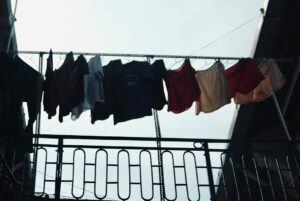In a world increasingly aware of environmental issues, upcycling has emerged as a creative and sustainable solution to waste. Among the many items that can be transformed, old jeans stand out as a versatile material. Denim, known for its durability and timeless appeal, offers endless possibilities for repurposing.
Upcycling old jeans not only reduces textile waste but also allows individuals to express their creativity and personal style. By turning a pair of worn-out jeans into a functional tote bag, one can breathe new life into an item that might otherwise end up in a landfill. The process of upcycling is not merely about recycling; it is about reimagining and reinventing.
Each pair of jeans carries its own story, and through upcycling, that narrative can continue in a new form. The tote bag created from old jeans can serve as a unique accessory, showcasing the wear and character of the fabric while also being practical for everyday use. This article will guide readers through the steps of transforming old jeans into a stylish tote bag, highlighting the joy and satisfaction that comes from creating something new from something old.
Key Takeaways
- Upcycling old jeans is a sustainable and creative way to give new life to your denim.
- When choosing jeans for upcycling, look for pairs with minimal wear and tear and in a size that suits your project.
- Preparing jeans for transformation involves washing and ironing them to ensure a clean and smooth surface for designing.
- Designing and planning your tote bag allows you to visualize the final product and make necessary adjustments before cutting and sewing.
- Cutting and sewing techniques for upcycling jeans require precision and attention to detail to ensure a professional-looking tote bag.
Choosing the Right Pair of Jeans for Upcycling
Selecting the right pair of jeans is crucial for a successful upcycling project. Not all denim is created equal, and certain factors should be considered when making this choice. First and foremost, the condition of the jeans plays a significant role.
Ideally, they should have minimal damage beyond what can be creatively incorporated into the design. A pair with interesting features, such as unique stitching or embellishments, can add character to the final product. Additionally, the weight and texture of the denim should be taken into account; heavier fabrics may provide more durability for a tote bag.
Another important consideration is the size of the jeans. A larger pair may yield more fabric, allowing for a spacious tote bag, while a smaller pair could result in a more compact design. The color and wash of the denim also influence the aesthetic appeal of the finished product.
Light-washed jeans can create a casual vibe, while dark-washed denim may lend a more sophisticated look. Ultimately, choosing the right pair of jeans involves balancing functionality with personal style preferences, ensuring that the final tote bag reflects the creator’s vision.
Preparing the Jeans for Transformation
Once the perfect pair of jeans has been selected, the next step is to prepare them for transformation. This process begins with cleaning the jeans thoroughly to remove any dirt or stains that may have accumulated over time. A gentle wash cycle followed by air drying is often sufficient to refresh the fabric without causing damage.
After cleaning, it is essential to inspect the jeans for any areas that may require repair or reinforcement before cutting into them. The next phase involves disassembling the jeans to maximize the usable fabric. This typically includes removing pockets, seams, and any embellishments that can be repurposed in the tote bag design.
Careful cutting is crucial during this stage; using sharp fabric scissors ensures clean edges and minimizes fraying. It is also advisable to keep track of all pieces removed from the jeans, as they may serve as valuable components in the final design. By taking these preparatory steps, one sets a solid foundation for a successful upcycling project.
Designing and Planning Your Tote Bag
| Metrics | Data |
|---|---|
| Tote Bag Size | 15″ x 15″ |
| Material | Cotton canvas |
| Color Options | Black, white, navy, red |
| Design Options | Custom logo, text, or artwork |
| Production Time | 7-10 business days |
With the jeans prepared, it is time to embark on the creative journey of designing the tote bag. This stage involves envisioning how the various pieces of denim will come together to form a cohesive and functional bag. Sketching out ideas can be incredibly helpful; it allows for experimentation with different shapes, sizes, and configurations before committing to cutting fabric.
Consideration should be given to practical elements such as strap length, pocket placement, and overall dimensions to ensure that the tote bag meets its intended purpose. In addition to functionality, aesthetics play a vital role in the design process. Mixing different shades of denim or incorporating contrasting fabrics can create visual interest and depth in the final product.
One might also consider adding unique features such as decorative stitching or appliqué designs that reflect personal style. Planning ahead not only streamlines the construction process but also enhances creativity by providing a clear roadmap for bringing the vision to life.
Cutting and Sewing Techniques for Upcycling Jeans
The cutting and sewing phase is where the transformation truly begins. Armed with a design plan, one can start cutting out the necessary pieces from the prepared denim. Precision is key during this stage; using a rotary cutter or fabric scissors ensures clean lines that will contribute to a polished final product.
It is advisable to cut pieces slightly larger than needed initially, allowing for adjustments during assembly. Sewing techniques can vary based on individual skill levels and available tools. For those new to sewing, using a sewing machine with a heavy-duty needle designed for denim can make the process smoother.
Straight stitches are often sufficient for basic seams, but incorporating zigzag stitches can help prevent fraying along raw edges. For added strength, double stitching along seams is recommended, especially in areas that will bear weight when carrying items in the tote bag. Assembling the pieces with care will ensure that the final product is both functional and aesthetically pleasing.
Adding Embellishments and Personal Touches
Once the basic structure of the tote bag is complete, it’s time to infuse it with personality through embellishments and personal touches. This stage allows for creativity to shine as one considers various ways to enhance the bag’s appearance. Pockets from the original jeans can be reattached in new configurations or used as decorative elements on the exterior of the bag.
Adding patches or appliqués made from other fabric scraps can create a unique design that tells a story. Furthermore, embellishments such as buttons, beads, or embroidery can elevate the tote bag from simple to extraordinary. These details not only enhance visual appeal but also provide an opportunity for self-expression.
Whether opting for a bohemian vibe with colorful patches or a minimalist approach with subtle stitching, personal touches make each tote bag one-of-a-kind. This stage is where creativity meets craftsmanship, resulting in a finished product that reflects individual style.
Reinforcing the Tote Bag for Durability
Durability is an essential consideration when creating an upcycled tote bag from old jeans. Given that denim is already known for its strength, additional reinforcement can ensure that the bag withstands daily use without compromising its integrity. One effective method is to add interfacing to areas that will experience significant stress, such as strap attachments or bottom seams.
This extra layer provides stability and helps maintain shape over time. Another way to enhance durability is by using strong thread specifically designed for heavy fabrics like denim. Reinforcing stress points with extra stitching or bar tacks can further increase longevity.
Additionally, considering how weight will be distributed within the bag can inform design choices; ensuring that straps are securely attached and evenly spaced will help prevent tearing or stretching over time. By prioritizing durability during construction, one can create a tote bag that not only looks good but also stands up to everyday wear and tear.
Styling and Customizing the Tote Bag
With the tote bag complete, it’s time to explore styling and customization options that allow for further personalization. The versatility of denim means it can easily adapt to various fashion styles, making it an excellent choice for any wardrobe. One way to style an upcycled tote bag is by pairing it with complementary outfits; its casual yet chic aesthetic makes it suitable for both everyday errands and more polished occasions.
Customizing accessories such as keychains or charms that hang from the tote’s straps can add an extra layer of flair. Additionally, experimenting with different ways to carry or wear the bag—such as slinging it over one shoulder or using both straps—can change its overall look and feel. The beauty of an upcycled tote bag lies in its ability to evolve with personal style preferences while remaining functional and eco-friendly.
Tips for Caring for Your Upcycled Tote Bag
Caring for an upcycled tote bag ensures its longevity and continued aesthetic appeal over time. Given that denim is generally durable, routine maintenance involves simple practices such as spot cleaning when necessary and avoiding excessive exposure to harsh elements like rain or direct sunlight. When washing becomes necessary, hand washing in cold water is often recommended to preserve color and prevent shrinkage.
Storing the tote bag properly when not in use can also extend its life; keeping it in a cool, dry place away from direct sunlight helps prevent fading and deterioration of fabric fibers. Regularly checking for signs of wear or damage allows for timely repairs before issues escalate. By following these care tips, one can enjoy their upcycled tote bag for years to come while minimizing environmental impact.
Ideas for Using Scrap Fabric and Denim for Additional Projects
The journey of upcycling does not have to end with creating a tote bag; there are countless ways to utilize leftover fabric scraps from old jeans for additional projects. Small pieces can be transformed into stylish coasters or placemats, adding a touch of rustic charm to home décor while reducing waste. Additionally, scraps can be sewn together to create patchwork items such as pillows or quilts that showcase various shades and textures of denim.
For those interested in fashion accessories, smaller scraps can be fashioned into hairbands or keychains, providing practical uses while maintaining an eco-friendly ethos. Even tiny remnants can find purpose; they can be used as stuffing for plush toys or decorative elements in mixed-media art projects. The possibilities are limited only by imagination, encouraging individuals to think creatively about how they can continue their upcycling journey beyond just one item.
Conclusion and Inspiration for Upcycling Other Clothing Items
In conclusion, upcycling old jeans into a stylish tote bag exemplifies how creativity can intersect with sustainability in meaningful ways. The process not only breathes new life into worn-out clothing but also fosters individuality through personalized design choices. As individuals embark on their upcycling journey with denim, they may find inspiration to explore other clothing items in their wardrobe that could benefit from similar transformations.
From t-shirts turned into reusable shopping bags to sweaters repurposed into cozy blankets, there are endless opportunities for creative expression through upcycling. Each project serves as a reminder of the value inherent in materials often deemed disposable while contributing positively to environmental conservation efforts. By embracing upcycling as both an art form and a sustainable practice, individuals can inspire others to rethink their relationship with clothing and foster a culture of creativity and resourcefulness in their communities.
If you’re interested in transforming your old jeans into stylish tote bags, you might also enjoy exploring the world of cozy and versatile fashion. A related article that delves into this theme is “Embracing Cozy Chic: A Journey Through the Fashionable Versatility of Sweaters.” This piece highlights how you can incorporate comfort and style into your wardrobe, much like how you can repurpose denim into fashionable accessories. For more inspiration on creating a chic and cozy look, check out the full article here.
FAQs
What materials do I need to turn old jeans into tote bags?
To turn old jeans into stylish tote bags, you will need a pair of old jeans, fabric scissors, sewing machine or needle and thread, and any additional embellishments or decorations you may want to add to the tote bag.
How do I turn old jeans into tote bags?
To turn old jeans into tote bags, start by cutting off the legs of the jeans and sewing the bottom of the pant legs shut. Then, cut off the waistband and use it as the handles for the tote bag. You can also add any additional decorations or embellishments to customize the tote bag to your liking.
What are the benefits of turning old jeans into tote bags?
Turning old jeans into tote bags is a great way to upcycle old clothing and reduce waste. It also allows you to create a unique and stylish tote bag that is both functional and environmentally friendly.
Can I personalize the tote bags made from old jeans?
Yes, you can personalize the tote bags made from old jeans by adding embellishments such as patches, embroidery, or fabric paint. This allows you to create a one-of-a-kind tote bag that reflects your personal style.
Are there any tips for turning old jeans into tote bags?
When turning old jeans into tote bags, it’s important to choose jeans that are in good condition and have enough fabric to create a functional tote bag. Additionally, take your time with the cutting and sewing process to ensure a professional-looking finished product.





